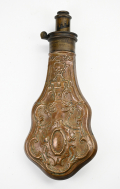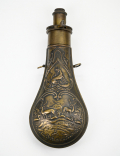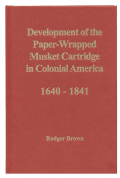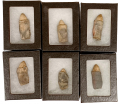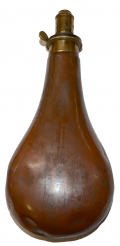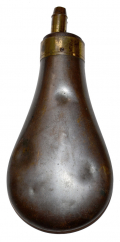site search
online catalog
Cartridges & Gun Tools
Showing 101 to 120 out of 122
DIXON & SON MARKED POWDER FLASK
This is a pretty powder flask with an adjustable spout and brown lacquered body impressed with a basket weave design on the faces and leaves curling up on either edge, with small brass suspension… (1184-74). Learn More »
HAWKSLEY MARKED POWDER FLASK
Good condition, plain body powder flask with prominent edge seam and adjustable spout measured in drams. Stamped “G.& J.W. HAWKSLEY / SHEFFIELD” on the top of the collar. Constructed with… (1184-71). Learn More »
TOMPION FOR BURNSIDE CARBINE
A wood tompion for a cavalryman’s .54 caliber Burnside carbine. This has the characteristic ball top, pointed tip, and cruciform slotted body of the Burnside tompions. They are occasionally seen in… (490-3945). Learn More »
HAWKSLEY POWDER FLASK
This has a wonderful profusion of design elements that seems to combine rococo foliate C-scrolls symmetrically arranged with some geometric ornaments- something in the “too much is not enough”… (1184-75). Learn More »
HAWKSLEY POWDER FLASK
A nicely decorated sportsman’s powder flask decorated in two panels with a hunting dog at top and the hunter’s prey at bottom: two stags with prominent antlers standing over a row of five less… (1184-73). Learn More »
DEVELOPMENT OF THE PAPER-WRAPPED MUSKET CARTRIDGE IN COLONIAL AMERICA, 1640-1841
Brown, Rodger. 2022. Hardback, 6 x 9 ¾”. 96 pages; numerous b&w photos and illustrations. During the Revolutionary War, both armies in the conflict were armed with muzzleloading smoothbore… (ST501205). Learn More »
SMALL HUNTER’S POWDER HORN
This horn dates roughly 1820-1850. It is a plain, working powder horn only about 5 ¼ inches long, a size sometimes thought to be just for priming powder for a flintlock, but convenient enough to be… (1184-79). Learn More »
SMALL HUNTER’S POWDER HORN
This horn dates roughly 1820-1850. It is a plain, working powder horn only about 5 3/4 inches long, a convenient size for pocket or hunting bag. Sometimes considered a small horn just for priming… (1184-77). Learn More »
“DUG” .50 CALIBER SMITH “RUBBER CASE” CARTRIDGES
Used in the Smith carbine extensively during the early years of the Civil War, we have several specimens of these unusual .50 caliber “rubber case” cartridges in excavated “relic”… (2022-1238). Learn More »
SYKES MARKED FLASK FOR POCKET OR MUFF PISTOLS
This small copper and brass flask is in near mint condition with a very pleasing brown lacquer tone to the copper body, medium untouched patina to the brass collar and spout, and vibrant blue to the… (30-2246). Learn More »
WOODEN CRATE FOR SHARPS CARBINES DATED AUGUST 1876
Wooden shipping crate for 10 sharps carbines. Crate is missing the lid but is marked on one end with a clear date of “AUGUST 1876.” The same edge has some faint markings that look to read “10… (172-5755). Learn More »
.45 CALIBER IRON PISTOL BALL MOLD & BARREL TOOL
Iron scissor-type mold to cast a lead round ball for revolvers. Measures approximately 3.5” long overall. Single cavity mold with spout. Sprue cutter is formed between the two handles. Cavity… (1164-46). Learn More »
VERY LARGE POWDER FLASK BY J. DIXON & SONS, SHEFFIELD
This very large flask has to have been for shotguns. Constructed with a copper body, with brass top and spout. Measures approximately 11” tall x 5” at widest point. Unadorned body. Thumb tab and… (172-5639). Learn More »
POWDER FLASK FOR REVOLVERS
This flask is for early pocket model revolvers. Constructed with a copper body, with brass top and spout. Measures approximately 6” tall x 2.75” at widest point. Both sides are plain. Thumb tab… (172-5638). Learn More »
RELIC M1873 MAYNARD BULLET MOLD
Iron bullet mold measures approximately 7 ½” long. Two halves pinned with rivet and has floating sprue cutter. Iron is pitted but not badly; could be “dug” or out of a barn. Still opens and… (1117-238). Learn More »
BRASS BULLET MOLD FOR “PICKET” TYPE BULLET
Scissor-type mold made of brass. Casts a .44 caliber “picket” or “sugarloaf” style of bullet with rounded base. Measures 6 ½” overall. Brass has a blotchy, dark patina. … (1117-234). Learn More »
ENGLISH PERCUSSION CAP PACK
This is a “pulp bag” of percussion caps as manufactured at the Royal Laboratory at Woolwich, England. Each pack was to contain 15 copper percussion caps. Packages are full of caps and twisted… (M25673). Learn More »
.54 CALIBER CARTRIDGE FOR FAYETTEVILLE RIFLE
Dark worn paper cartridge with conical bullet in nose. The body of the cartridge is complete but the paper looks weary. The tail has separated from the cartridge due to age and weakness of the… (169-280). Learn More »
$200.00
Originally $250.00
.577 CALIBER ENGLISH ENFIELD PATTERN CARTRIDGE
Fabricated by Ludlow Brothers of Birmingham, England. Nice display in a 8.25” x 12.25” Riker case. Photocopy of an original wrapper at top with info sheet below, and then the cartridge at the… (M24051). Learn More »
OPENED FULL PACK OF 1870 SPENCER CARBINE BLANKS
Pack has the original brown wrapper and label but string is replacement. Top is cut and held in place by string. Lid can be lifted to view cartridges. Light blue label with black printing reads “10… (172-3989). Learn More »
Showing 101 to 120 out of 122
Most Popular
Historical Firearms Stolen From The National Civil War Museum In Harrisburg, Pa »
Theft From Gravesite Of Gen. John Reynolds »
Selection Of Unframed Prints By Don Troiani »
Fine Condition Brass Infantry Bugle Insignia »
Large English Bowie Knife With Sheath 1870’S – 1880’S »
Imported (Clauberg) Us Model 1860 Light Cavalry Officer's Saber »
featured item
IDENTIFIED ISSUE RED BLANKET OF THEODORE P. BOWKER 13th MASSACHUSETTS - DIED OF WOUNDS AT ANTIETAM!
This is a rare, early-war, identified Massachusetts issue red blanket carried by a soldier in the 13th Massachusetts who was wounded at Antietam on Sept. 17, 1862, and died of those wounds at a U.S. hospital at Rappahannock Station on November 12.… (490-7138). Learn More »






